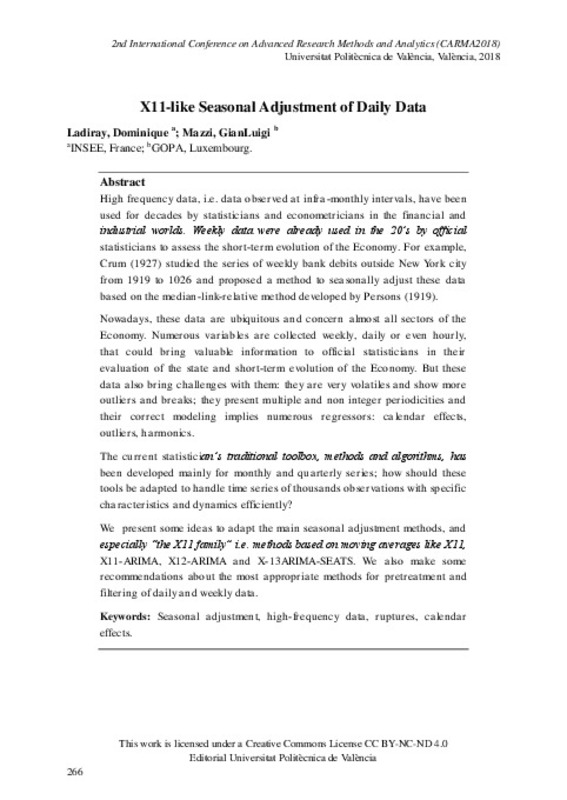JavaScript is disabled for your browser. Some features of this site may not work without it.
Buscar en RiuNet
Listar
Mi cuenta
Estadísticas
Ayuda RiuNet
Admin. UPV
X11-like Seasonal Adjustment of Daily Data
Mostrar el registro sencillo del ítem
Ficheros en el ítem
| dc.contributor.author | Ladiray, Dominique
|
es_ES |
| dc.contributor.author | Mazzi, Gian Luigi
|
es_ES |
| dc.date.accessioned | 2018-11-05T07:57:18Z | |
| dc.date.available | 2018-11-05T07:57:18Z | |
| dc.date.issued | 2018-09-07 | |
| dc.identifier.isbn | 9788490486894 | |
| dc.identifier.uri | http://hdl.handle.net/10251/111839 | |
| dc.description | Resumen de la ponencia | es_ES |
| dc.description.abstract | [EN] High frequency data, i.e. data observed at infra-monthly intervals, have been used for decades by statisticians and econometricians in the financial and industrial worlds. Weekly data were already used in the 20’s by official statisticians to assess the short-term evolution of the Economy. For example, Crum (1927) studied the series of weekly bank debits outside New York city from 1919 to 1026 and proposed a method to seasonally adjust these data based on the median-link-relative method developed by Persons (1919). Nowadays, these data are ubiquitous and concern almost all sectors of the Economy. Numerous variables are collected weekly, daily or even hourly, that could bring valuable information to official statisticians in their evaluation of the state and short-term evolution of the Economy. But these data also bring challenges with them: they are very volatiles and show more outliers and breaks; they present multiple and non integer periodicities and their correct modeling implies numerous regressors: calendar effects, outliers, harmonics. The current statistician’s traditional toolbox, methods and algorithms, has been developed mainly for monthly and quarterly series; how should these tools be adapted to handle time series of thousands observations with specific characteristics and dynamics efficiently? We present some ideas to adapt the main seasonal adjustment methods, and especially “the X11 family” i.e. methods based on moving averages like X11, X11-ARIMA, X12-ARIMA and X-13ARIMA-SEATS. We also make some recommendations about the most appropriate methods for pretreatment and filtering of daily and weekly data. | es_ES |
| dc.format.extent | 1 | es_ES |
| dc.language | Inglés | es_ES |
| dc.publisher | Editorial Universitat Politècnica de València | es_ES |
| dc.relation.ispartof | 2nd International Conference on Advanced Reserach Methods and Analytics (CARMA 2018) | es_ES |
| dc.rights | Reconocimiento - No comercial - Sin obra derivada (by-nc-nd) | es_ES |
| dc.subject | Web data | es_ES |
| dc.subject | Internet data | es_ES |
| dc.subject | Big data | es_ES |
| dc.subject | QCA | es_ES |
| dc.subject | PLS | es_ES |
| dc.subject | SEM | es_ES |
| dc.subject | Conference | es_ES |
| dc.subject | Seasonal adjustment | es_ES |
| dc.subject | High-frecuency data | es_ES |
| dc.subject | Ruptures | es_ES |
| dc.subject | Calendar effects | es_ES |
| dc.title | X11-like Seasonal Adjustment of Daily Data | es_ES |
| dc.type | Capítulo de libro | es_ES |
| dc.type | Comunicación en congreso | es_ES |
| dc.identifier.doi | 10.4995/CARMA2018.2018.8574 | |
| dc.rights.accessRights | Abierto | es_ES |
| dc.description.bibliographicCitation | Ladiray, D.; Mazzi, GL. (2018). X11-like Seasonal Adjustment of Daily Data. En 2nd International Conference on Advanced Reserach Methods and Analytics (CARMA 2018). Editorial Universitat Politècnica de València. 266-266. https://doi.org/10.4995/CARMA2018.2018.8574 | es_ES |
| dc.description.accrualMethod | OCS | es_ES |
| dc.relation.conferencename | CARMA 2018 - 2nd International Conference on Advanced Research Methods and Analytics | es_ES |
| dc.relation.conferencedate | Julio 12-13,2018 | es_ES |
| dc.relation.conferenceplace | Valencia, Spain | es_ES |
| dc.relation.publisherversion | http://ocs.editorial.upv.es/index.php/CARMA/CARMA2018/paper/view/8574 | es_ES |
| dc.description.upvformatpinicio | 266 | es_ES |
| dc.description.upvformatpfin | 266 | es_ES |
| dc.type.version | info:eu-repo/semantics/publishedVersion | es_ES |
| dc.relation.pasarela | OCS\8574 | es_ES |








